NHS Scotland assets and facilities 2017: annual report
Seventh edition of the state of NHS Scotland assets and facilities report (SAFR).
Annex A
Review of NHSScotland’s Property Assets
This Annex provides a detailed analysis of property, vehicles, medical equipment and IM&T asset performance which supports the summarised information provided in the main body of the report.
The responsibility for the management of NHSScotland’s assets rests with 14 NHS Boards and 8 National NHS Boards.
| National NHS Boards | |
|---|---|
| NHS Education for Scotland | NHS Health Scotland |
| NHS National Services Scotland | NHS National Waiting Times Centre |
| Healthcare Improvement Scotland | NHS 24 |
| Scottish Ambulance Service | The State Hospitals Board for Scotland |
The information presented in this annex combines information from all 22 NHS Boards and National NHS Boards, however, some charts and tables split the analysis between the 16 Boards with in-patient accommodation (labelled NHS Boards), i.e. all 14 NHS Boards plus the NHS Golden Jubilee Hospital and the State Hospitals Board for Scotland, and the 6 remaining National NHS Boards.
It should be noted that all information presented in this section is broadly based on April 2017 information, unless otherwise stated.
Asset Value
NHSScotland owns physical assets that are worth circa £7.2bn, the majority of which relates to the estate (land and buildings), but also includes owned vehicles, medical equipment and information management and technology (IM&T) assets.

Taken from Boards’ accounts information
The NHS also has assets which it does not own including buildings, vehicles, medical equipment and IM&T. These assets are estimated to be worth a further £1.4bn, the majority of which are hospitals and health centres managed under Public Private Partnership (PPP) agreements. Also, the majority of cars used by NHSScotland staff are leased, with staff paying for their own non-business element of these leased vehicles.
In addition to the NHSScotland owned and leased property assets, there are numerous smaller properties used to provide a range of community and family health services provided by GPs, Pharmacists, Dentists and Opticians, many of which are owned or leased by these independent practitioners themselves and paid for indirectly by the NHS through a range of charging and re-imbursement mechanisms.
Note: the higher Net Book Value reported this year is taken directly from all NHS Boards’ financial accounts, rather than previously being reported from submitted information.
Estate Size
The NHSScotland estate comprises circa 4.4m. sq.m of building floor area encompassing buildings ranging in size from 40 sq.m to 200,000 sq.m. The majority of this is the hospital estate of the 14 NHS Boards and 2 National NHS Boards (NHS Golden Jubilee Hospital and the State Hospitals Board). The 2016 ISD Cost Book records this hospital estate as 200 hospitals with a total building area of 3.56m sq.m.
The other property types that account for the further 0.82m sq. m. includes health centres & clinics, day centres, offices, residential accommodation, and industrial / storage units.
The table that follows shows an analysis of the hospital estate by type of hospital in terms number of sites and building area.
| Acute | Long Stay | Mental Health | Psychiatric & LD | Community | Other | Total | |
|---|---|---|---|---|---|---|---|
| Number of Hospitals | 37 | 39 | 27 | 12 | 65 | 22 | 202 |
| Hospital Area (million sq.m) | 2.29 | 0.25 | 0.42 | 0.06 | 0.23 | 0.31 | 3.56 |
| Percentage of total area (rounded) | 64% | 7% | 12% | 2% | 6% | 9% | 100% |
The above table shows that whilst community hospitals are the most numerous (65) they only represent 6% of the total hospital estate in terms of building area i.e. a large number of small hospitals. In contrast, the 37 acute hospitals account for 64% of the total hospital estate in terms of building area.
The total number of hospitals included in this analysis has reduced by 14 since last year, mainly due to a combination of consolidation of services onto single sites, disposal of redundant properties following completion of new facilities in previous years (e.g. site rationalisation following completion of the Queen Elizabeth University Hospital in Glasgow), and some minor reporting re-classification of certain properties. However, the overall used floor area has increased in the same period which is a further indicator of the rationalisation of smaller, redundant properties as services move to larger, modernised estate.
It should also be recognised that a number of the hospitals included in the broad categorisation of “Long Stay Hospitals” includes hospitals with acute long stay beds, psychiatric long stay beds and psychiatric day hospitals. These hospitals may also have other types of beds which are not classified as “long stay”.
Providing services more locally is an integral part of the 2020 Vision and this is expected to have an impact on the size and distribution of the hospital estate. Subsequent changes in the hospital estate will continue to be monitored as part of SAFR in future years.
The current distribution of the hospital estate (by numbers of hospitals and by area sq.m) across the Boards is shown in the tables that follow.
| Distribution of hospitals across the NHS Boards | |||||||
|---|---|---|---|---|---|---|---|
Board |
Acute | Long Stay | Mental Health | Psychiatric & LD | Community | Other | Total |
| NHS Greater Glasgow | 7 | 4 | 6 | 1 | 0 | 4 | 22 |
| NHS Lanarkshire | 3 | 5 | 2 | 1 | 4 | 0 | 15 |
| NHS Tayside | 3 | 2 | 4 | 2 | 8 | 5 | 24 |
| NHS Dumfries & Galloway | 2 | 3 | 1 | 2 | 6 | 2 | 16 |
| NHS Ayrshire & Arran | 3 | 3 | 1 | 1 | 3 | 0 | 11 |
| NHS Grampian | 4 | 1 | 3 | 1 | 17 | 2 | 28 |
| NHS Lothian | 4 | 11 | 2 | 1 | 2 | 2 | 22 |
| NHS Fife | 2 | 1 | 3 | 1 | 4 | 0 | 11 |
| NHS Highland | 4 | 4 | 1 | 0 | 14 | 3 | 26 |
| NHS Borders | 1 | 4 | 2 | 1 | 3 | 2 | 13 |
| State Hospital | 0 | 0 | 1 | 0 | 0 | 0 | 1 |
| NHS Western Isles | 1 | 0 | 0 | 0 | 1 | 1 | 3 |
| Golden Jubilee | 0 | 0 | 0 | 0 | 0 | 1 | 1 |
| NHS Orkney | 1 | 0 | 0 | 0 | 0 | 0 | 1 |
| NHS Shetland | 1 | 0 | 0 | 0 | 0 | 0 | 1 |
| NHS Forth Valley | 1 | 1 | 1 | 1 | 3 | 0 | 7 |
| 202 | |||||||
| Distribution of hospital estate by area (sq.m) | ||
|---|---|---|
| Board | Total area sq.m | Percentage of NHSScotland Total Area |
| NHS Greater Glasgow | 1.02 | 29% |
| NHS Lothian | 0.56 | 16% |
| NHS Tayside | 0.38 | 11% |
| NHS Grampian | 0.32 | 9% |
| NHS Fife | 0.25 | 7% |
| NHS Highland | 0.22 | 6% |
| NHS Lanarkshire | 0.21 | 6% |
| NHS Ayrshire & Arran | 0.20 | 6% |
| NHS Forth Valley | 0.15 | 4% |
| NHS Dumfries & Galloway | 0.07 | 2% |
| NHS Borders | 0.06 | 2% |
| Golden Jubilee | 0.06 | 2% |
| State Hospital | 0.02 | 1% |
| NHS Western Isles | 0.02 | 1% |
| NHS Shetland | 0.01 | 0.3% |
| NHS Orkney | 0.01 | 0.2% |
| 3.56 | 100% | |
Estate Tenure
The majority of the NHSScotland estate is owned (78%) but for some NHS Boards PPP/PFI (including NPD and Hub) and leased property is a significant proportion of their estate, as shown in the charts that follow.

Tenure profile above includes all 22 NHS Boards and
National NHS Boards, where information is available
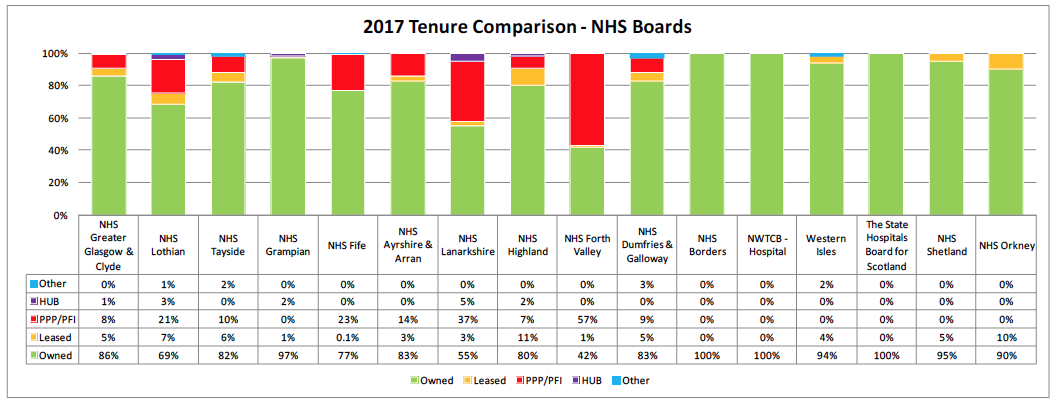
The majority of office accommodation occupied by National NHS Boards is leased.
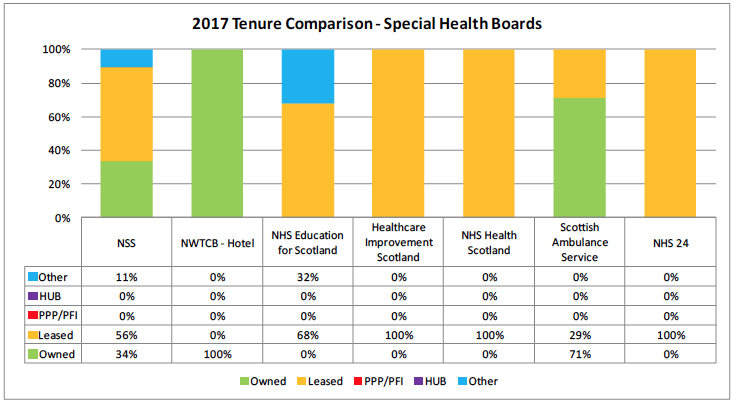
Estate Age
NHSScotland occupies approximately 820,000 sq.m (19% of the total) of relatively new / modern accommodation (i.e. less than 10 years old), which is an increase of 153,000 sq.m since 2011, and is evidence of the significant capital investment in property assets over recent years. There does, however, remain scope for improvement and further investment or disposal in the estate in order to move away from old, poor quality and functionally unsuitable properties. The following charts show the range of property ages for the NHS Boards, which indicates that 22% of the estate remains over 50 years old (note that some older properties are refurbished to modern standards rather than replaced).
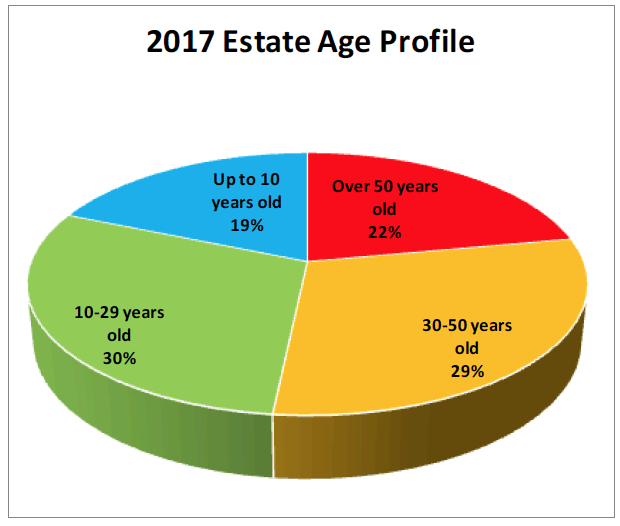
Age profile above includes all 22 NHS Boards and National NHS Boards
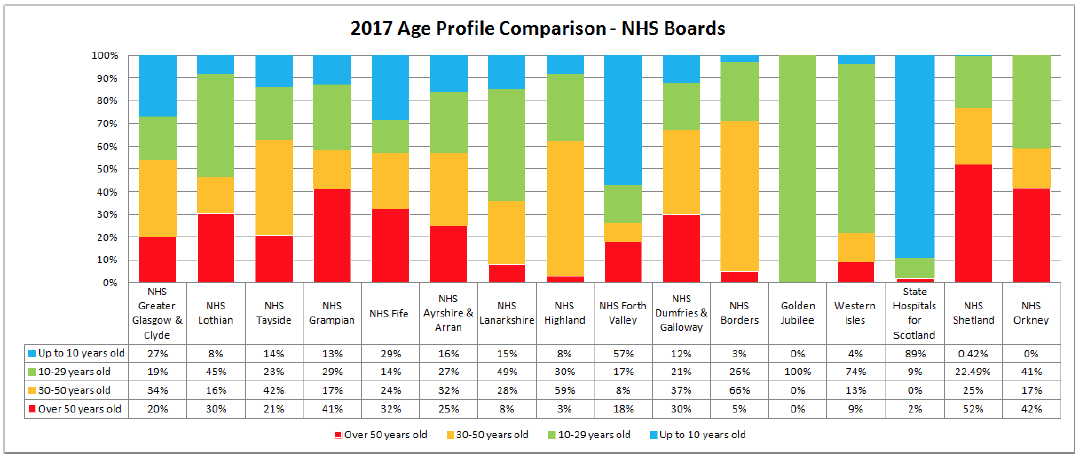
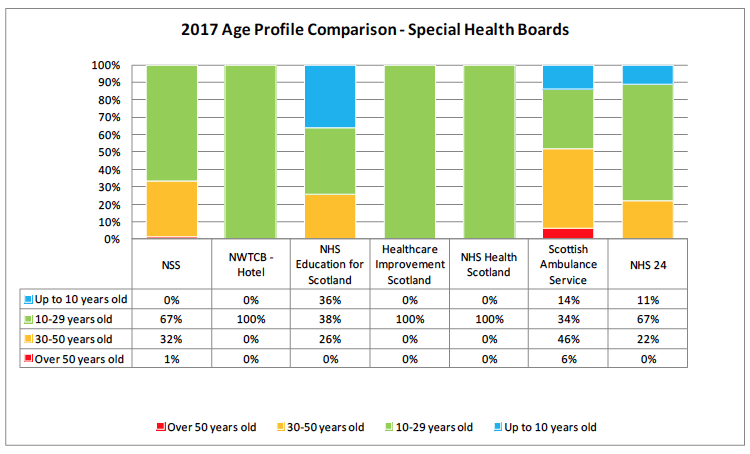
Estate Condition
The Boards report that 72% of their estate is in good physical condition (category A or B) with 25% requiring investment to improve its condition (category C) and 3% being unsatisfactory and requiring major investment or replacement (category D).
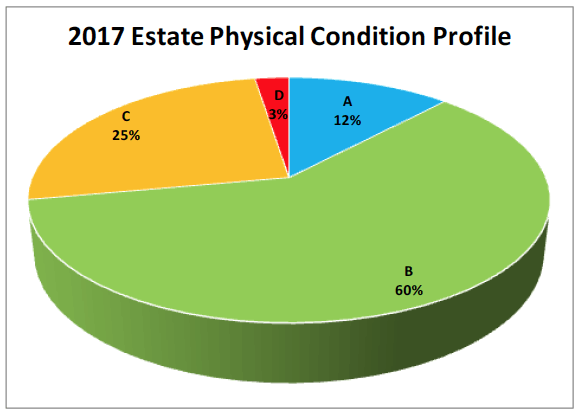
The proportion of the estate in good physical condition of 72% is higher than the 70% reported in the 2016 SAFR. Boards advise that this is as a result of the rationalisation of parts of the NHSScotland estate following completion of associated property replacement projects.
The two charts that follow highlight the variance in condition across the NHS Boards.
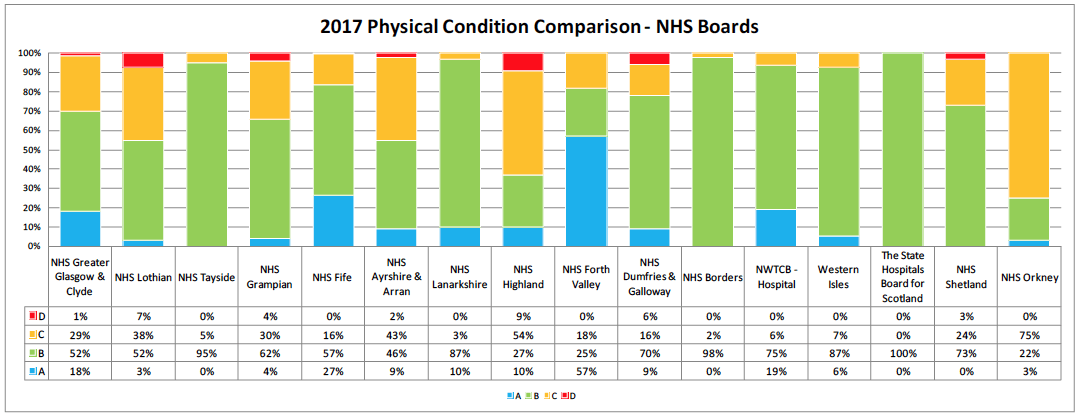
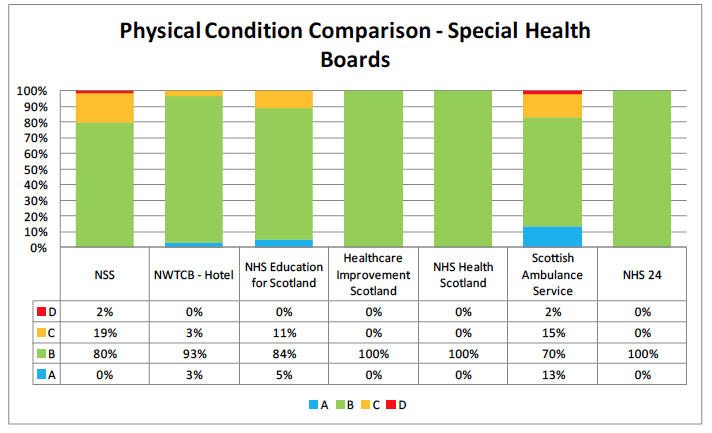
Further to the above Board level analysis, it is now possible through the Estate Asset Management System (EAMS) to report on estate KPIs such as physical condition and backlog maintenance at hospital level. Analysis of this information is being used by NHS Boards to link their property improvement needs and their strategic & service plans for improvement included within their PAMS.
NHS Boards which have buildings assessed as category D – “unsatisfactory” have indicated that they have plans in place to either dispose, replace, or improve these buildings over the next 5-10 years.
Estate Utilisation
Accommodation space has a direct relationship with cost. The aim, therefore, is to hold only that space which is needed to support the delivery and support of effective and efficient service delivery. Analysis of the information contained within each NHS Board’s Property and Asset Management Strategy shows that approximately 83% of the NHSScotland estate is fully utilised although some under utilisation and some overcrowding is evident as shown in the chart below.
This profile has remained the same as reported in 2016 SAFR.

The following charts highlight that space utilisation can vary across the NHS Boards.

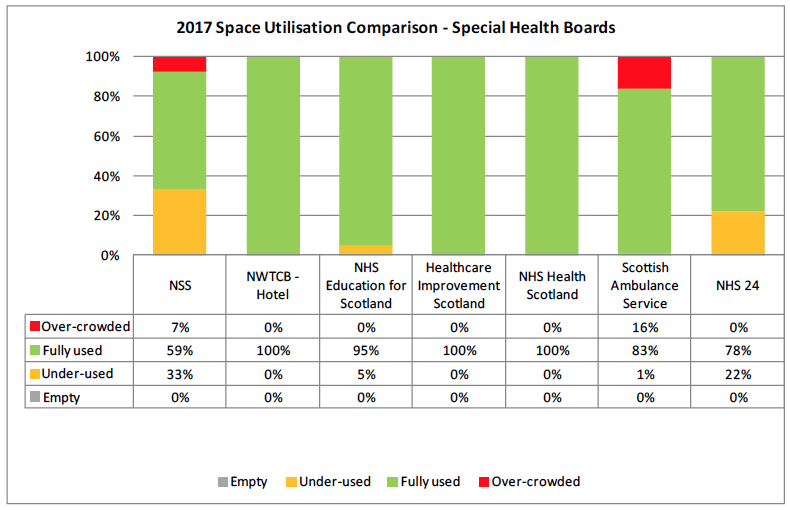
The under utilisation of accommodation across NHS Highland and NHS Orkney reflects the challenges faced from such a geographically diverse area and the need to maintain and provide critical healthcare facilities in locations with relatively low population masses.
Estate functional suitability
The estate also plays an important role in supporting the effective delivery of services. Poor functional suitability often results in inefficient working practices, increased staffing levels and poor clinical outcomes. Approximately 70% of the NHSScotland estate is functionally suitable but, as shown in the charts that follow, this can vary significantly across NHS Boards.
This profile shows a slight 1% increase in the area of the estate in categories A & B compared to that reported in 2016. Boards have advised that this is as a result of the annual re-assessment of buildings for functional suitability.



Performance Improvement of Property Assets
The following chart provides a comparative overview of performance improvement in property assets between 2016 and 2017.
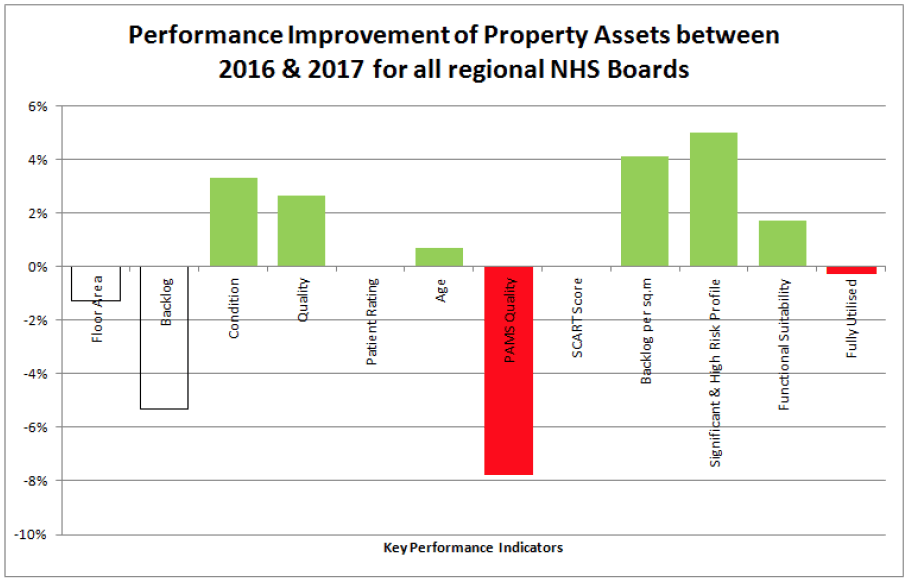
Note: green bars above the horizontal indicate a positive improvement whereas a red bar below the horizontal indicates a performance reduction.
The backlog analysis excludes inflation for comparative purposes.
The PAMS Quality assessments take place every two years hence score are compared over a two year period.
The above chart highlights a general improvement this year in each of the performance KPI’s; with improvements for physical condition, quality, backlog maintenance and functional suitability. The reduced score for PAMS quality is due to the introduction of new assessment criteria which sets a new, more challenging baseline; which Boards are expected to improve upon in subsequent years.
Contact
There is a problem
Thanks for your feedback